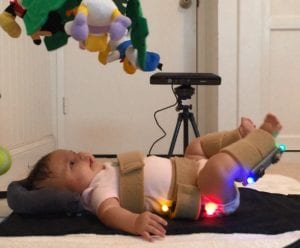
We believe that to achieve optimal functional outcomes, infants at risk for neurodevelopmental disabilities must be identified early and participate in intensive, carefully engineered, targeted therapy programs during infancy when their neural circuitry is developing.
Our research focuses on understanding infant motor learning and motor control to inform the early identification and intervention of infants at risk for neurodevelopmental disabilities.
Current projects include:
Quantifying Selective Motor Control of Infants at High Risk of Cerebral Palsy
Infants at high risk of cerebral palsy have reduced selective hip-knee control. The purpose of this study is to: (1) quantify the selective control of infants with cerebral palsy while spontaneously kicking from 1 to 9 months of age, and (2) determine if participating in specific tasks, such as actively reaching with a foot to touch a toy or actively taking steps on a treadmill from 3 to 9 months of age, increases selective control. IMPACT: Potential for earlier identification of cerebral palsy and informs early intervention. PI: Barbara Sargent, PhD, PT, PCS. Supported by the National Institutes of Health K12, the Foundation for Physical Therapy Research, and the Academy of Pediatric Physical Therapy.
News release: Gammon K. USC physical therapy researcher Barbara Sargent aims to detect cerebral palsy in infants earlier than ever before. 2019 (click here)
Locomotor Exploratory Behaviors of Infants born Preterm and Full-Term

Infants born preterm are at increased risk of learning and motor impairments that may delay walking skills. The purpose of this study is to determine if infants born preterm that are provided dynamic body-weight support demonstrate new walking behaviors and if they can learn walking tasks to promote selective hip-knee control. IMPACT: Informs early intervention. PI: Nora Almoadi, MS, PT (Saudi Arabia). Supported by the Cerebral Palsy Foundation.
Investigating Early Prone Mobility of Infants born Preterm and Full-Term

Infants born preterm demonstrate delayed crawling, but the specific factors contributing to this delay are unknown. In addition, there is limited evidence on how crawling may influence other areas of development. The purpose of this study is to: (1) determine if infants born preterm demonstrate more forward prone mobility and coordinated movements when provided dynamic body-weight support versus without it, and (2) determine if crawling skill affects other areas of development, e.g., object exploration or parent-infant dyadic interaction. IMPACT: Informs early intervention. PI: Ai-Tzu (Ellie) Chan, MS, OT (Taiwan). Supported by the Cerebral Palsy Foundation.
Feasibility of an In-home Standing and Walking Intervention for Infants with and at High Risk of Cerebral Palsy
 Infants with and at high risk of cerebral palsy are at increased risk of learning and motor impairments that may delay walking skills. The purpose of this study is to evaluate the feasibility of an early, intensive 4-month parent-led standing and walking intervention that uses an in-home body-weight support for infants with or at high risk of cerebral palsy. Impact: Informs early intervention for infants with and at high risk of cerebral palsy. PI: Barbara Sargent, PhD, PT, PCS. Supported by the California Physical Therapy Association and the Cerebral Palsy Foundation.
Infants with and at high risk of cerebral palsy are at increased risk of learning and motor impairments that may delay walking skills. The purpose of this study is to evaluate the feasibility of an early, intensive 4-month parent-led standing and walking intervention that uses an in-home body-weight support for infants with or at high risk of cerebral palsy. Impact: Informs early intervention for infants with and at high risk of cerebral palsy. PI: Barbara Sargent, PhD, PT, PCS. Supported by the California Physical Therapy Association and the Cerebral Palsy Foundation.
Therapeutic Intervention Supporting Development from the Neonatal Intensive Care Unit (NICU) to 6 months for Infants Post Hypoxic-Ischemic Encephalopathy
 The purpose of this pilot clinical trial to to evaluate the feasibility of a therapeutic intervention designed to support the development of infants with hypoxic-ischemic encephalopathy (HIE) during the first 6 months of life. IMPACT: Informs early intervention for infants with HIE. PI: Barbara Sargent, PhD, PT, PCS; Stacey Dusing, PhD, PT, PCS, FAPTA. Supported by the NIH National Pediatric Rehabilitation Resource Center (C-Progress).
The purpose of this pilot clinical trial to to evaluate the feasibility of a therapeutic intervention designed to support the development of infants with hypoxic-ischemic encephalopathy (HIE) during the first 6 months of life. IMPACT: Informs early intervention for infants with HIE. PI: Barbara Sargent, PhD, PT, PCS; Stacey Dusing, PhD, PT, PCS, FAPTA. Supported by the NIH National Pediatric Rehabilitation Resource Center (C-Progress).
SIT-PT: Comparing Two Physical Therapy Approaches for Young Children Beginning to Sit.
 The SIT-PT research team is comparing the effectiveness of two physical therapy interventions for young children with or at high risk of cerebral palsy. Through this study, we hope to better understand which intervention approach is best to promote children’s early development and readiness to learn. IMPACT: Informs early intervention. PI: Dusing, Harbourne. Supported by the National Institutes of Health. Click here for more information: https://start-play.unl.edu/SIT-PT/
The SIT-PT research team is comparing the effectiveness of two physical therapy interventions for young children with or at high risk of cerebral palsy. Through this study, we hope to better understand which intervention approach is best to promote children’s early development and readiness to learn. IMPACT: Informs early intervention. PI: Dusing, Harbourne. Supported by the National Institutes of Health. Click here for more information: https://start-play.unl.edu/SIT-PT/
Development of a Selective Control Assessment of the Lower Extremity for Infants and Toddlers (Mini-SCALE)
The Selective Control Assessment of the Lower Extremity (SCALE) quantifies selective motor control of children with cerebral palsy over 4 years of age. The purpose of this study is to develop Mini-SCALE, a selective control assessment of the lower extremity for infants and toddlers from 3 months to 4 years of age. IMPACT: Informs assessment of infants and toddlers with cerebral palsy. PI: Fowler. Supported by the Cerebral Palsy Foundation. Click here for more information on the original SCALE: https://www.uclahealth.org/ccp/scale

